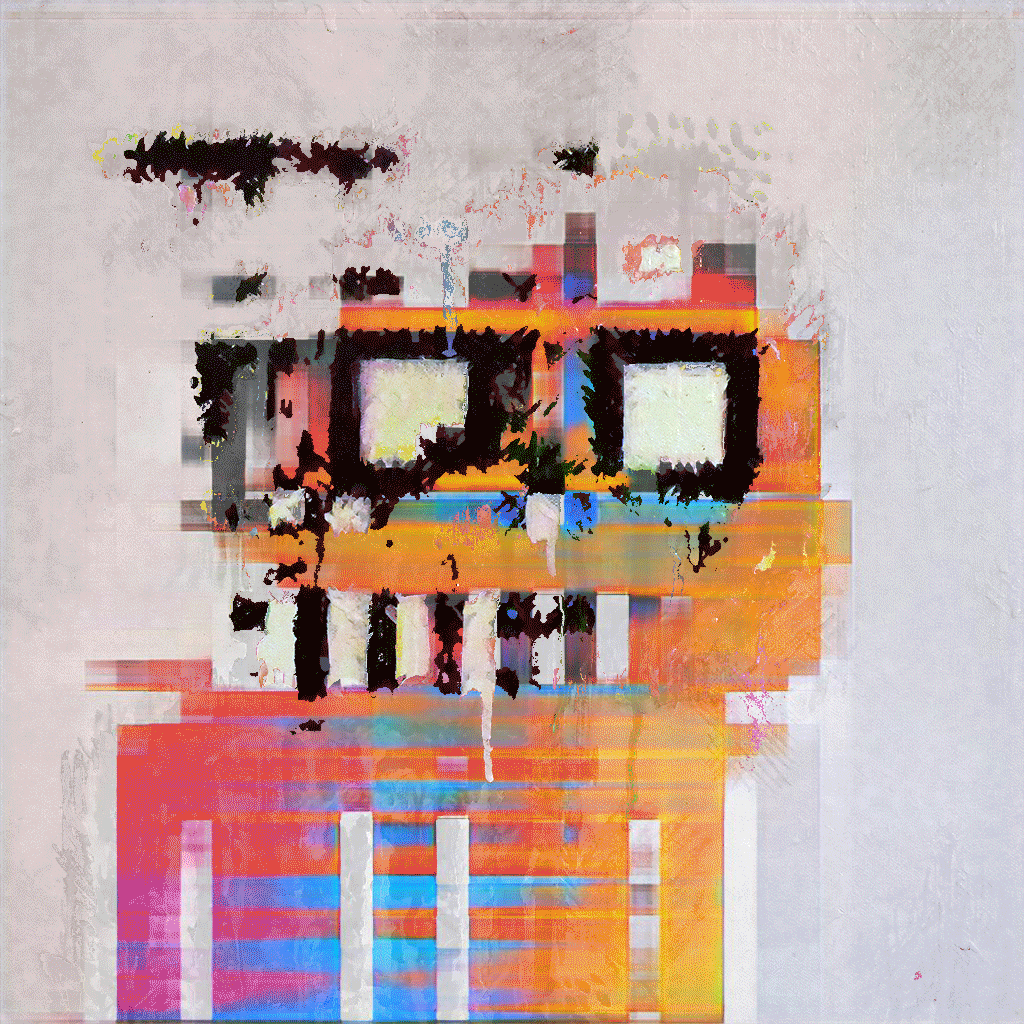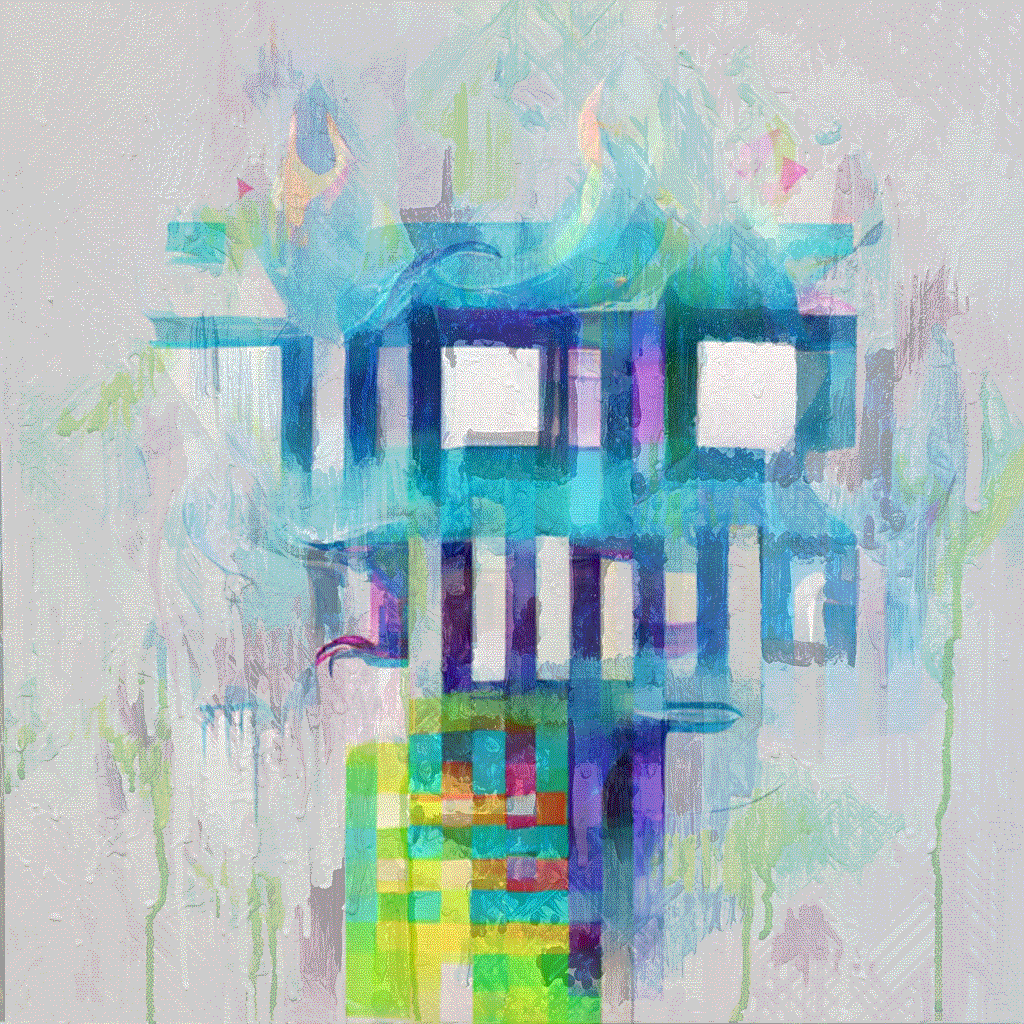
Above: “Quantum Faces” by Pindar Van Arman on SuperRare
Pindar Van Arman and the Future of Quantum Art
“Quantum work is where the future is,” said AI artist Pindar Van Arman, whose work reimagines physical reality through the lens of quantum computing. Van Arman made his mark creating and collaborating with artificially intelligent painting robots, and has since added quantum computing to the mix.
Today, Van Arman reveals his latest work “Quantum Faces” on SuperRare, further distilling the gentle instability that exists between atoms. “By using actual quantum computers and artificial intelligence to procedurally generate these portraits,” he said, “they come out resembling the quantum phenomenon occurring within us.”
But to know Van Arman’s future, it helps to know his past.
A lifelong artist, in 2005 he started designing autonomous painting robots that use deep learning neural networks, feedback loops, and computational creativity.
The impetus came from a simple desire to collaborate. “Wouldn’t it be cool,” Van Arman asked himself, “to have an assistant that painted with me?” He settled on a painting robot to help him create, and in those early days before NFTs, Van Arman would sell his robot paintings on eBay. He’d only make a couple of hundred dollars per sale, so he increased production by building five painting robots. Still, Van Arman didn’t gain recognition for his work until art began to populate the blockchain. In crypto, he found forward-thinking individuals adopting new forms of value and embracing AI applications in art, creating something like “a natural peanut butter and chocolate marriage made in heaven.”
Van Arman established himself in the NFT world with his popular GANs and Imagined AI series, which references crypto culture and crypto art history. Paired with his innovative AI style, he explored the differences and similarities between human and computational creativity.
His latest work, “Quantum Faces,” begins with individual atoms that are manipulated by a quantum computer, formulated into an image by artificial intelligence, and then painted by a robot. The NFT features multiple frames stitched together to create a moving picture.
“This is definitely a throwback to the elements and pieces which got me a [Robot Art] award in 2018,” he added, referring to “AI Imagined Portrait Painted by a Robot,” his first work minted on SuperRare. The piece was an early application of GANS (generative adversarial networks), and used AI and feedback loops (a technique Van Arman created that allows the robot to take photos of the painting and analyze the work as it goes) along with neural networks. “I used AI to imagine a face and then I had my robots paint them,” he said. “It was literally painting brushstrokes, minimalistically, until it saw a face. And once it saw a face, it stopped.” Van Arman made 256 pieces in the series, which led to a frenzied demand for more work.
But with “Quantum Faces,” Van Arman has added more layers onto his technology game. “This is early use of quantum computing to make art,” he explained. “It’s very hard to get on these quantum computers and to run programs and get data out of them,” he added. “So, it’s kind of novel in that way.”
Quantum Nuts and Bolts
“Quantum Faces” doesn’t use feedback loops in the process. Instead, it utilizes measurements of atoms to achieve random results. “You can see the quantum principles in the artwork,” said Van Arman. “It’s sort of like this quantum visualization of the way it was made; the visualization [becomes] the actual piece of art.” And in that way, “the form mimics the function.”
Programming on a quantum computer is nothing like programming on a traditional computer. In order to begin, one has to design the quantum circuit and then write code that will run on that circuit. The aesthetic advantages of using a quantum computer include superposition, entanglement, interference, and noise.
Noise is defined as errors. And atoms are glitchy. Van Arman found beauty in these natural glitches and thus took advantage of the noise. “The reason that we love glitch art is because it represents something underlying in the universe that’s natural to us, that we don’t see on a macro level, but it’s true in a micro level [and] on a quantum level.”
Creating quantum computer art also has interesting processing advantages; you can make the art as a reflection of quantum interference between the probabilities of the qubits’ evolution during the computation. “Superposition is the fact that your piece of data can be both the one and the zero, or every possibility in between, all at the same time,” Van Arman explained. “It gets very powerful when you’re using AI.”


Pindar Van Arman in the studio, courtesy of the artist
The physicists who have seen “Quantum Faces” have also described moments when the faces in the composition resemble what they would imagine a superposition would look like. “If you’re trying to observe an atom [in] superposition, it could be to the right, left, it could be middle,” said Van Arman. “It could be any combination, anywhere in between.” This helps produce a sense of movement in the artwork.
Van Arman also sees the concept of entanglement–where two atoms are linked together forming a single coherent state in which their fundamental physical properties interfere and combine with each other–as another tool to play with in quantum computing artwork. “I make my program that generates this space maximally entangled. So, every atom’s entangled with each other. I use five atoms, entangle them, and measure them all to get random results,” he said. “Scientists have likewise told me there are moments in this piece where you see the face on the left, on the right, and they’re moving in the same way, but they’re separated.” Quantum physicists have also told Van Arman they could see interference in his artwork. “There are times where the faces collide with each other and when they’re colliding, you get this interference pattern,” he said, which is part of what makes the piece feel so volatile, yet kaleidoscopic.



“Quantum Faces” by Pindar Van Arman
Repeatability
“One of the reasons it is so important for me to use my robots to make paintings is because each of those paintings is unique,” Van Arman noted. “But now that I can tap into the random elements of quantum computing, I can actually get random results when running code. I can get truly random results when creating a piece of art.”
On a traditional, classical computer, though it may appear that a piece of generative art is unique, the algorithms rely on a pseudo-random seed that, when used again, will create the exact same artwork. “If you’re tapping into a quantum computer to get the random element that AI needs, then you can never replicate the piece of art that comes out,” Van Arman observed. “The universe will run out of time before you can make that piece of art again. Even if you brute-force and try every combination of a seed phrase or you run my algorithm constantly on a supercomputer until the end of history, you will never repeat that piece of art.”
This element of scarcity is important to Van Arman, not only as an artist trying to sell work, but also as an artist trying to make something new every time. “It gives this piece of authenticity that everyone’s after. It makes a unique piece of art. And that’s only one of the advantages of using a quantum computer in a generative algorithm workflow.”
The Future
Van Arman predicts that in five years, quantum computing generative algorithms will be as popular with artists as GANs are now. Using himself as a barometer, he states, “I am as excited about using quantum computing to make generative art as I was about using GANs to make art back then.”
Looking towards tomorrow, Van Arman conceded that “the largest quantum computer I’ve used today is 27 qubits, basically 27 atoms. IBM just released one with 127. I think you can do some pretty powerful, pretty awesome things [using] 127 atoms.”
“I don’t think it makes a difference to the art right now,” he added, but the fact that a big part of creating unique art will use AI that is quantum-based is particularly exciting. “The reason why the AI has to be quantum-based is so that it can be truly random, truly unique, and truly unrepeatable. That’s key.”


Harmon Leon is the the author of eight books—the latest is: 'Tribespotting: Undercover (Cult)ure Stories.' Harmon's stories have appeared in VICE, Esquire, The Nation, National Geographic, Salon, Ozy, Huffington Post, NPR’s 'This American Life' and Wired. He's produced video content for Vanity Fair, The Atlantic, Timeline, Out, FX, Daily Mail, Yahoo Sports, National Lampoon and VH1. Harmon has appeared on This American Life, The Howard Stern Show, Last Call With Carson Daly, Penn & Teller’s Bullshit, MSNBC, Spike TV, VH1, FX, as well as the BBC—and he's performed comedy around the world, including the Edinburgh, Melbourne, Dublin, Vancouver and Montreal Comedy Festivals. Follow Harmon on Twitter @harmonleon.
Art



Curated Conversations: ALIENQUEEN
SuperRare Labs Senior Curator An interviews ALIENQUEEN about psychedelics, death, and her journey in the NFT space.
Tech


Out of the Vault and onto the Chain: the Evolving Nature of Provenance
SuperRare editor Oli Scialdone considers the social experience of provenance and its relationship with community in the Web3 space.
Curators' Choice



Curated Conversations: ALIENQUEEN
SuperRare Labs Senior Curator An interviews ALIENQUEEN about psychedelics, death, and her journey in the NFT space.





